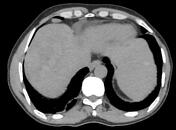16 results found
Article
Labeled imaging anatomy cases
This article lists a series of labeled imaging anatomy cases by body region and modality.
Brain
CT head: non-contrast axial
CT head: non-contrast coronal
CT head: non-contrast sagittal
CT head: non-contrast axial with clinical questions
CT head: angiogram axial
CT head: angiogram coronal
...
Article
Point-of-care ultrasound (curriculum)
The point-of-care ultrasound (PoCUS) curriculum is one of our curriculum articles and aims to be a collection of articles that represent the core applications of ultrasonography in a point-of-care setting.
Point-of-care ultrasound refers to ultrasonography which may be simultaneously performed,...
Article
Hypertriglyceridemia-induced pancreatitis
Hypertriglyceridemia-induced pancreatitis is an uncommon form of acute pancreatitis caused by high levels of circulating triglycerides in the blood.
Epidemiology
Hypertriglyceridemia-induced pancreatitis accounts for around 1-4% of cases of acute pancreatitis and is the third most common cause...
Article
Light bulb sign (hepatic hemangioma)
The light bulb sign of a hepatic hemangioma is a feature than can be seen on MRI imaging with a classic hepatic hemangioma. This refers to marked hyperintensity seen on heavily T2 weighted sequences that has been likened to a glowing light bulb.
See also
light bulb sign - shoulder
light bulb ...
Article
Acute cholecystitis (summary)
This is a basic article for medical students and other non-radiologists
Acute cholecystitis refers to the acute inflammation of the gallbladder. It is the primary complication of cholelithiasis and the most common cause of acute pain in the right upper quadrant (RUQ).
Reference article
This i...
Article
Klatskin tumor
Klatskin tumor is a term that was traditionally given to a hilar (perihilar) cholangiocarcinoma, occurring at the bifurcation of the common hepatic duct. Typically, these tumors are small, poorly differentiated, exhibit aggressive biologic behavior, and tend to obstruct the intrahepatic bile duc...
Article
Liver biopsy (percutaneous)
Percutaneous liver biopsy, utilizing either ultrasound or CT guidance, allows for an accurate and reliable method of acquiring hepatic tissue for histopathological assessment. It is divided into two types:
non-focal or non-targeted liver biopsy (used in the assessment and staging of the parench...
Article
Liver trauma
The liver is one of the most frequently damaged organs in blunt trauma, and liver trauma is associated with a significant mortality rate.
Epidemiology
In blunt abdominal trauma, the liver is injured ~5% (range 1-10%) of the time 1,3.
Clinical presentation
Patients can present with right uppe...
Article
Splenic infarction
Splenic infarction is a result of ischemia to the spleen, and in many cases requires no treatment. However, identification of the cause of infarction is essential.
Epidemiology
Splenic infarcts can occur due to a number of processes, involving either arterial supply, the spleen itself or the...
Article
Acute cholecystitis
Acute cholecystitis refers to the acute inflammation of the gallbladder. It is the primary complication of cholelithiasis and the most common cause of acute pain in the right upper quadrant (RUQ).
Epidemiology
Acute cholecystitis is a common cause of hospital admission and is responsible for a...
Article
Bile duct stricture
Bile duct strictures are problematic in terms of management and distinction between benign and malignant.
Pathology
Etiology
There are numerous causes of biliary duct strictures, including 1,2:
malignant
cholangiocarcinoma
involvement by pancreatic head adenocarcinoma
involvement by ampul...
Article
Autosplenectomy
Autosplenectomy denotes spontaneous infarction of the spleen with resulting hyposplenism.
Epidemiology
Autosplenectomy is most frequently encountered in patients with homozygous sickle cell disease, although it has also been reported in pneumococcal septicemia 1, and systemic lupus erythematos...
Article
Functional gallbladder disorder
Functional gallbladder dysfunction refers to biliary pain due to motility disturbance of the gallbladder without gallstones, biliary sludge, microlithiasis or microcrystals.
Terminology
The disorder has been or is known by several other names, including gallbladder dysfunction, gallbladder dys...
Article
Gallstones
Gallstones, also called cholelithiasis, are concretions that may occur anywhere within the biliary system, most commonly within the gallbladder.
Terminology
Gallstones (cholelithiasis) describe stone formation at any point along the biliary tree. Specific names can be given to gallstones depe...
Case
Infiltrative hepatocellular carcinoma

Published
11 Jan 2023
77% complete
CT
Case
Bile duct stricture

Published
13 May 2014
71% complete
MRI









 Unable to process the form. Check for errors and try again.
Unable to process the form. Check for errors and try again.